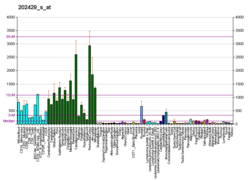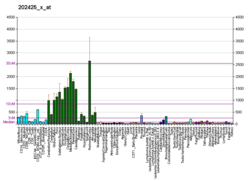| PPP3CA |
|---|
 |
| Available structures |
|---|
| PDB | Ortholog search: PDBe RCSB |
|---|
| List of PDB id codes |
|---|
1AUI, 1M63, 1MF8, 2JOG, 2JZI, 2P6B, 2R28, 2W73, 3LL8, 4F0Z, 4Q5U, 5C1V |
|
|
| Identifiers |
|---|
| Aliases | PPP3CA, CALN, CALNA, CALNA1, CCN1, CNA1, PPP2B, protein phosphatase 3 catalytic subunit alpha, IECEE, IECEE1, ACCIID, DEE91 |
|---|
| External IDs | OMIM: 114105; MGI: 107164; HomoloGene: 55497; GeneCards: PPP3CA; OMA:PPP3CA - orthologs |
|---|
| Gene location (Human) |
|---|
 | | Chr. | Chromosome 4 (human)[1] |
|---|
| | Band | 4q24 | Start | 101,023,409 bp[1] |
|---|
| End | 101,348,278 bp[1] |
|---|
|
| Gene location (Mouse) |
|---|
 | | Chr. | Chromosome 3 (mouse)[2] |
|---|
| | Band | 3|3 G3 | Start | 136,375,885 bp[2] |
|---|
| End | 136,643,488 bp[2] |
|---|
|
| RNA expression pattern |
|---|
| Bgee | | Human | Mouse (ortholog) |
|---|
| Top expressed in | - Brodmann area 23
- endothelial cell
- middle temporal gyrus
- Region I of hippocampus proper
- postcentral gyrus
- Brodmann area 46
- entorhinal cortex
- orbitofrontal cortex
- external globus pallidus
- pons
|
| | Top expressed in | - olfactory tubercle
- hippocampus proper
- lateral septal nucleus
- globus pallidus
- nucleus accumbens
- anterior amygdaloid area
- lobe of cerebellum
- subiculum
- Region I of hippocampus proper
- prefrontal cortex
|
| | More reference expression data |
|
|---|
| BioGPS | 

 | | More reference expression data |
|
|---|
|
| Gene ontology |
|---|
| Molecular function | - calcium ion binding
- phosphoprotein phosphatase activity
- protein dimerization activity
- protein serine/threonine phosphatase activity
- metal ion binding
- calmodulin binding
- protein binding
- protein heterodimerization activity
- enzyme binding
- calcium-dependent protein serine/threonine phosphatase activity
- hydrolase activity
- cyclosporin A binding
- calmodulin-dependent protein phosphatase activity
| | Cellular component | - membrane
- plasma membrane
- calcineurin complex
- nucleoplasm
- Z disc
- mitochondrion
- sarcolemma
- nucleus
- cytosol
- cytoplasm
- cytoplasmic side of plasma membrane
- dendritic spine
- slit diaphragm
- cell projection
- synapse
- Schaffer collateral - CA1 synapse
- glutamatergic synapse
| | Biological process | - multicellular organismal response to stress
- negative regulation of insulin secretion
- protein import into nucleus
- transition between fast and slow fiber
- negative regulation of chromatin binding
- response to amphetamine
- modulation of chemical synaptic transmission
- positive regulation of DNA-binding transcription factor activity
- response to calcium ion
- Fc-epsilon receptor signaling pathway
- cardiac muscle hypertrophy in response to stress
- negative regulation of dendrite morphogenesis
- skeletal muscle fiber development
- positive regulation of cardiac muscle hypertrophy in response to stress
- excitatory postsynaptic potential
- T cell activation
- cellular response to glucose stimulus
- calcium ion transport
- calcium-mediated signaling
- dephosphorylation
- positive regulation of transcription by RNA polymerase II
- Wnt signaling pathway, calcium modulating pathway
- positive regulation of cardiac muscle hypertrophy
- positive regulation of gene expression
- negative regulation of gene expression
- negative regulation of production of miRNAs involved in gene silencing by miRNA
- positive regulation of connective tissue replacement
- positive regulation of endocytosis
- G1/S transition of mitotic cell cycle
- protein dephosphorylation
- calcineurin-NFAT signaling cascade
- positive regulation of calcineurin-NFAT signaling cascade
- brain development
- positive regulation of cell migration
- skeletal muscle tissue regeneration
- positive regulation of cell adhesion
- calcineurin-mediated signaling
- postsynaptic modulation of chemical synaptic transmission
- human ageing
- peptidyl-serine dephosphorylation
| | Sources:Amigo / QuickGO |
|
| Orthologs |
|---|
| Species | Human | Mouse |
|---|
| Entrez | | |
|---|
| Ensembl | | |
|---|
| UniProt | | |
|---|
| RefSeq (mRNA) | |
|---|
NM_001130692
NM_000944
NM_001130691 |
| |
|---|
| RefSeq (protein) | |
|---|
NP_000935
NP_001124163
NP_001124164 |
| |
|---|
| Location (UCSC) | Chr 4: 101.02 – 101.35 Mb | Chr 3: 136.38 – 136.64 Mb |
|---|
| PubMed search | [3] | [4] |
|---|
|
| Wikidata |
| View/Edit Human | View/Edit Mouse |
|




















